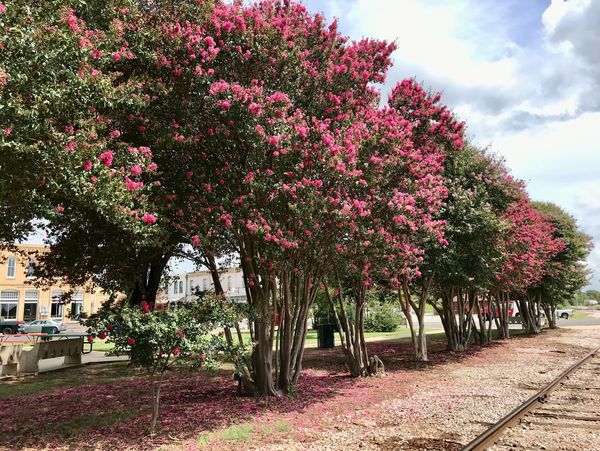
Elgin's Crepe Myrtles
By Sydna Arbuckle
After World War II ended in 1945, most people in Elgin found their lifestyles changing. Many men and women had worked at Camp Swift, and when the "Camp" closed, they were again without jobs as they had been during the "Great Depression." Federal programs were developed to help educate and train in new areas of work, and cities were asked to make plans to reach program goals.
The federal Post-War Planning Board, organized after the end of World War II, stepped in a similar way that the Work Progress Administration (WPA) had previously done. New government projects were instituted combining federal and state efforts to help soldiers and communities. Assistance to provide employment and education in farming, industry, and local beautification was provided by the federal government.
The Elgin City Council met in 1944 (prior to the end of the war) to address “Some Post-War Plans to Materialize." One plan dealt with federal assistance to finance city utilities, as well as giving crepe myrtle plants to cities that requested them. Elgin was thrilled that Mayor Buck Christian wanted to order 1600 crepe myrtle plants and make Elgin a "Crepe Myrtle” city like other towns in Texas that had already received them. The ladies who were members of the Elgin New Century Club were thrilled and worked diligently as they convinced citizens to order and plant these bushes that required very little attention. Many were planted in Veterans Park in downtown Elgin and in front of homes along Main Street. They are still blooming after 80 years and are usually in full bloom from May through September. Elgin held a celebration after all the plants were planted by city workers and property owners.

The crepe myrtle was designated as the State Shrub of Texas in 1997, even though they are not native trees. They were brought to the southern United States in the late 1700s from China. The bushes that may develop into trees are perfect in many ways for the climate and conditions found in Texas. These plants require very little water and care and can be propagated from trimmed “switch” limbs that originally had red and white blossoms. Through extensive trials, plants can have blooms that are purple, lilac, pink, or orange.
More about the history of the WPA should be noted. After World War I, the United States was in a terrible financial situation. Women seldom worked outside their homes, and over 20% of the men lost jobs, homes, and savings. They were forced to wait in bread lines and live in shantytowns. Attempting to come out of the depression, President Franklin Roosevelt created the WPA, which was an employment and infrastructure agency that provided jobs for public works projects of building schools, hospitals, roads, and even a way of preserving museums and concert halls for arts and music. As President Roosevelt gathered men to help organize the WPA from different professions, it is interesting to note that one young such man was an Elgin notable. Luther Evans and his family were from Elgin. Evans was the Librarian of Congress and later the president of UNESCO (United Nations Educational and Cultural Organization).

Elgin received help through the WPA for public works by creating a museum at Main and Avenue C and helping with utilities, bridge building, and art work, such as the mural at the post office. The WPA had a lasting impact in Elgin in the 1930s.
World unrest grew again, and the United States declared war in 1941. The WPA contained various departments, but early in the 1940s President Roosevelt urged breaking up these departments. The states organized individual Post-War Planning Boards for projects when the war ended. With men being drafted, employees in WPA activities were lacking. The edict from the federal government was to cease improving local infrastructure, The WPA was dissolved in 1943.
In 1945, the Elgin City Council dealt with public improvements with the idea to purchase land to build a park. The land ultimately became Elgin Memorial Park, although the improvements that were envisioned were not built at that time. Few people realize that in 1945, Main Street turned left in front of Dorothy Cartwright's house at Eleventh Street, continued to the intersection of North Avenue C, and turned right and went to Highway 95. The extension of Main Street along Memorial Park to Highway 95 did not occur for another decade.
Photos by Sonia Browder
This website uses cookies.
We use cookies to analyze website traffic and optimize your website experience. By accepting our use of cookies, your data will be aggregated with all other user data.